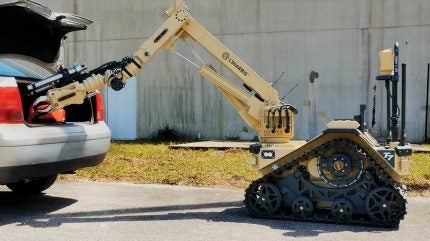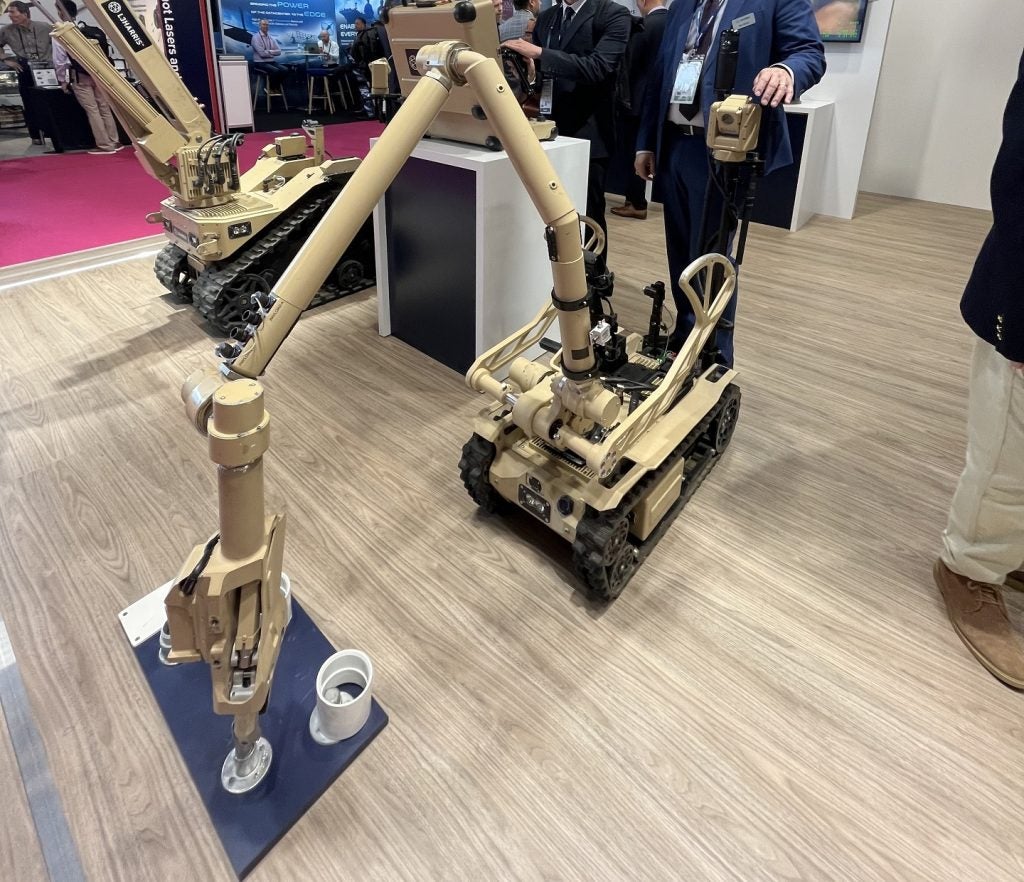
In an interview at Eurosatory 2024, Eric Garris, L3Harris’s Advanced Concepts Engineer, discussed the latest advancements in their T4 and T7 bomb disposal robotic systems.
A focus has been placed on increased dexterity, operational efficiency, and future-proofing through dual-arm capabilities.
In an interview, Eric Garris, an Advanced Concepts Engineer at L3Harris, shed light on the company’s ongoing efforts to enhance the functionality of these systems.
Evolution of the T7 and T4 bomb disposal robots
“The T7 has been in service with the UK since 2018. It was designed to handle large vehicle-borne improvised explosive devices (IEDs) and other high-threat scenarios,” Garris began. “It was a replacement for what had historically been the wheel nearer robot in the market that had existed all the way since the 1970s. The T4, launched in 2019, is a medium-class robot, optimised for environments with tighter access requirements like planes, trains, and buses.”
Weighing in at 320kg, the T7 is equipped to tackle threats, often requiring specialised deployment vehicles. In contrast, the T4, at just 103kg, can be disassembled into two components for easy transport, even fitting into the trunk of a sedan.
“The T4 takes the T7’s capabilities into a smaller, more accessible format,” Garris noted.
Future developments and new capabilities
Looking ahead, L3Harris is focused on expanding the functionality of the T4 and T7 platforms. One feature in development is a dual-arm capability, an advancement that will enhance the robots’ dexterity and operational efficiency.
“We’re currently working on a dual-arm capability in the US market that combines a highly dexterous seven-degree arm with a strong five-degree arm,” Garris revealed.
Global reach and market expansion
The T4 and T7 are already seeing success on the global stage. Garris highlighted several contracts, including a deal with the UK Ministry of Defence and a recent order from the Australian Defence Force. The versatility of the T4, in particular, has been a selling point, with Australia opting for a five-to-one ratio of T4s to T7s.
“The T4 really punches above its capability,” Garris said. “It can pick up more than half its body weight, making it an incredibly strong option for a medium-sized platform.”
Operational successes and capabilities
L3Harris’ robotic platforms are designed to operate in some of the most challenging environments, from the tight confines of urban areas to the extreme conditions of desert landscapes.
“Our platforms are truly capable of interoperating with electronic countermeasure (ECM) kit,” Garris explained. “In the UK, for example, our robots can function in jamming environments, which is critical for minimising the impact on surrounding areas during threat neutralisation operations.”
These capabilities also extend to extreme climates, with the T7 proving its mettle in Northern Africa’s harsh conditions, enduring temperatures up to 60°C. Additionally, the robots are designed to fire disruptors without sustaining damage—a feature well-received by customers who have previously dealt with more fragile systems.
The future of bomb disposal robotics
As for the future, Garris is confident that L3Harris will continue to lead the charge in EOD technology. “EOD is a core business for us, and it’s not going away,” he asserted. “There’s still a significant amount of unexploded ordnance worldwide.”
In addition to their current capabilities, L3Harris is exploring new applications for their robotic platforms, including large-area clearance and route clearance operations. These mission sets will see robots defeating individual threats but working in tandem with convoys or clearing entire airfields.
Hands-on with the haptic controller

One of the features of L3Harris’ robotic systems is their haptic controller, which provides users with a tactile experience that enhances precision and control. “We’ve had instances where operators that typically use joystick-based systems were able to complete complex tasks, like navigating through double doors. With previous systems, it would take about 20 minutes to get through those two doors. In a matter of probably less than half an hour of training after switching to our haptic controller, they were able to go through the two doors in less than 5 minutes,” Garris shared.
This controller, which has its roots in underwater applications, has been adapted to the EOD market. It offers an intuitive interface that allows operators to control the robot’s movements as naturally as if they were manipulating objects with their own hands.
“With our system, you simply look at the door handle, rotate the controller, grab, and open—the system (robot) does the rest, resolving all the motion, algorithm, and control for you,” Garris concluded.







